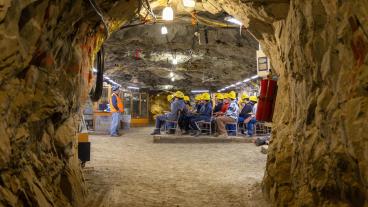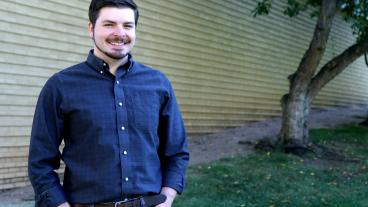By Todd Neff
Enrollment numbers at Mines suggest it’s a hot new field of study, but this is a subject with a long, long history.
We’re talking about physics, the realm of Archimedes, Copernicus, Newton, Faraday, Maxwell, Curie, Bohr and, of course, Einstein. Mines saw its number of undergraduate physics majors leap from 114 students in 2001 to 258 in 2012. Since 2006, the school has graduated an average of 56 physics majors a year, placing the program among the four largest in the country, in a league with Massachusetts Institute of Technology, University of California at Berkeley and University of Maryland at College Park.
Indeed, Mines has one of the nation’s top undergraduate physics programs, a distinction reflected by its receipt of one of just four American Physical Society’s Improving Undergraduate Physics Education awards in 2013.
Perhaps some of the heightened interest in physics has to do with a growing consciousness that the field is humanity’s best attempt at decoding the language of the universe. Or perhaps students recognize that a foundation in everything from electrical to gravitational to quantum phenomena can apply to a broad range of fields and even make one a better citizen in a world where numbers are policy. But this wasn’t always the case.
Physics II, like Physics I, is a requirement for most Mines students, with about 900 students taking one of the two courses in a given semester. For a long time, it wasn’t exactly popular, said Thomas Furtak, head of the Mines Department of Physics.
“Physics II used to be one of the most hated courses here,” Furtak said. “It was difficult material, and every student had to take it.”
With 40 percent dropping, withdrawing from or failing these classes, Furtak and colleagues in the late 1990s decided to revamp the program. Their goals, expressed in the well-founded buzzwords of the time, were to provide:
- “authentic experiences” with problems that were not merely academic
- something “context rich” and connected to everyday life
- something “experiential” and not just involving working out things on paper
- and something social that involved students arriving at a “negotiated understanding” via mutual explanation and listening
These guidelines and a model pioneered in 1994 at Rensselaer Polytechnic Institute drove a curriculum and classroom development effort that led to an all new “studio physics” approach in Physics I in 2001 and in Physics II in 2006. Both involve a pair of one-hour lectures and two-hour studios per week.
Daryl McPadden, a senior physics major, is a teaching assistant in Physics II, which covers electricity, circuitry, magnetism and optics. On a day designated as “Capacitor Studio,” McPadden stood at the fringe of a Computer Commons classroom customized for studio physics. There were eight clusters of tables, each with four work stations. Two or three students sat at each station, outfitted with a flat-screen monitor, digital multimeter, function generator, circuit box, DC power supply, oscilloscope, sensor interface for data collection and small plastic hardware cabinet. Stainless steel bars were vice-gripped at the edge of each station, remnants from a Physics I class that had used dangled weights from springs to study oscillating motion. To all this, students added their scientific calculators, notebooks and papers with circuit diagrams and equations.
“You only get one capacitor,” said David Flammer, the instructor. “Don’t blow it up. I’m going to show you how to blow one up in a minute.”
The experiment involved charging and discharging a capacitor through a thermistor, whose ability to resist current withers with rising temperature. Flammer directed students to a Wikipedia page on resistor color-coding and asked that McPadden and fellow teaching assistants not answer questions for 15 minutes.
“If we hold back as TAs, it helps them problem-solve — as opposed to us fixing it for them,” McPadden explained.
Students walked through the exercise, connecting wires and reading meters, discussing possible approaches and next steps. When they ran into roadblocks, they consulted each other or raised their hands. McPadden or another of the five undergraduate TAs on hand then helped.
“Switch it over to five. See what happens? See, you’re not actually calibrated to zero,” McPadden told a team at table three.
Freshman Katie Schumacher and sophomore Parker Schuster worked together at the next table. On their screen, the online course-management software displayed a page titled “Thermistor Intro.”
“Studio kind of gives you a real-world sense of what’s going on. It makes it relevant,” Schuster said. “And it helps when other students help you, too,” Schuster added.
McPadden says the studio courses helped ignite her interest in physics. In general, the rates of those dropping, withdrawing or failing required physics courses have fallen by half, and other Mines programs — including biology and math, are considering the approach. Farther afield, Mines faculty have assisted the faculty of the University of Wyoming and Abu Dhabi’s Petroleum Institute in implementing studio courses.
The senior research project has been the other big development in the Mines Physics Department. Launched in 2006, it builds on research skills introduced during a required six-week summer session boot camp Mines students attend between their sophomore and junior years.
“We train students in everything from ultrahigh vacuum techniques to computer numerical-control machining, computer networking and optical technology,” Furtak said. “They learn a lot of things that many physics students elsewhere don’t know until the end of their first year of graduate training.”
The idea of the senior project, Furtak said, is to “merge the research interests of the faculty member and the research activities going on in our graduate program to create an undergraduate experience that is valuable to them.”
All 17 tenure-track faculty propose projects, which number in the dozens. In September, seniors choose one they like. McPadden and Mines senior David Bicknase chose one proposed by Furtak and colleague Reuben Collins. Their project: Passivation and Size Control of Solution-Processed ZnO Quantum Dots.
In a corner of a Meyer Hall lab, McPadden explained that she was interested in renewable energy applications, and that zinc oxide quantum dots could be relevant as a bridge between inorganic and organic solar cells. Each Sunday, she and Bicknase spend several hours in the lab, using zinc acetate and sodium hydroxide to grow quantum dots and then sort out the particles’ surface chemistry using a spectrophotometer.
“We’re looking at the bandgap energy of the particles,” added Bicknase. “The spectrum shifts depending on size, increasing as the particles get smaller.”
They’ve had to be creative at times, such as when their flasks began tipping over after transfer from hot water to ice baths. The solution? A colorful support lattice made from K’NEX construction toys. By the end of their senior year, they will have written the equivalent of a journal article on the topic and presented a poster. A key part of the experience is learning how to communicate their ideas, Furtak said.
McPadden hopes to earn a PhD and specialize in physics education; Bicknase is deciding whether to pursue an academic track or work in industry. Either way, they’ll be prepared, Furtak said, because understanding fundamental principles of nature helps physicists explore new frontiers.
“Physicists are really good at that, whether it’s exploring black holes or black paint,” he said.
This article appears in the 2013-14 edition of Mines' research magazine, "Energy and the Earth."



